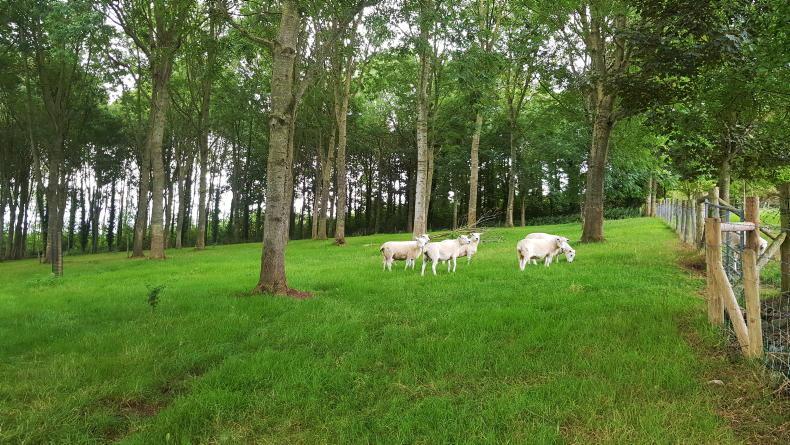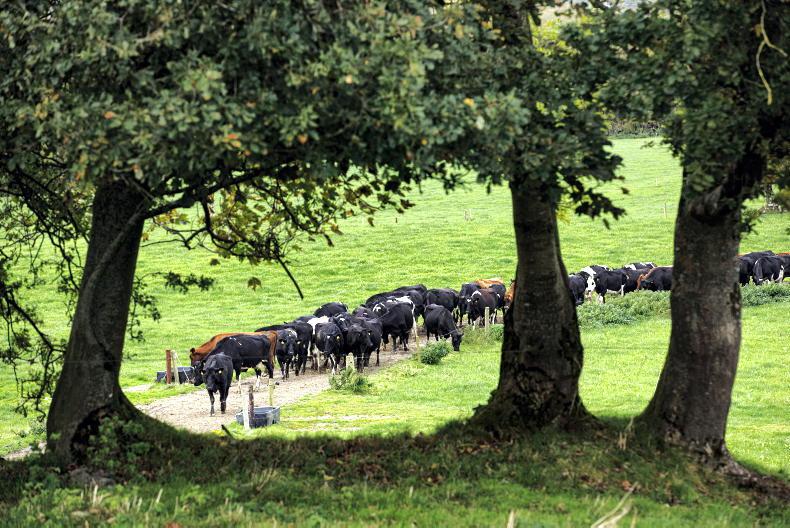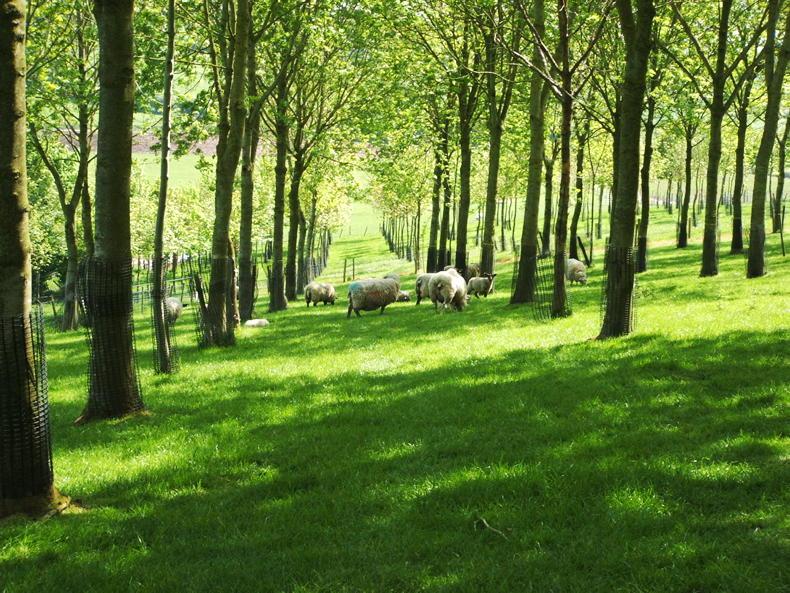Ireland has committed to reducing greenhouse gas emissions by 51% relative to a 2018 baseline by 2030 and agroforestry has been shown that it can contribute towards it.
Agroforestry is the collective name for land use systems and technologies where woody perennials, trees, shrubs, palms and bamboos are deliberately used on the same land management units as agricultural crops and livestock.
This diversification of the farming system initiates land use systems and practices where perennials are deliberately integrated with crops and/or animals on the same parcel of land.
This creates an agro ecological succession, such as that in natural ecosystems, and so starts a chain of events that enhance the functionality and sustainability of the farming system.
This silvopastoral agroforestry system is the intentional combination of agriculture and forestry has multiple benefits, such as greatly enhanced yields from food crops, enhanced farmer livelihoods from income generation, increased biodiversity, improved soil structure and health, reduced erosion and carbon sequestration.

Sheep graze the agroforestry as part of a rotational grazing system.
Agroforestry is tipped to be the roadmap towards neutrality, rather than stimulating sustainable agricultural production.
Through research and innovation, farmers are being encouraged to use developed technologies and practices to decrease environmental impacts, without negatively affecting production, profitability or formula.
Agroforestry has proven to be successful within an EU context.
Strategy
The recently published forestry strategy 2030 encourages EU member states to accelerate the roll-out of carbon farming practices and, for this, agroforestry is being mooted as one way of doing it through various eco schemes.
There's also a pledge from Europe to plant an extra three billion trees, during that period up to 2030 and, within that document, agroforestry and planting trees in agricultural land is cited as a sustainable way forward.
There are a number of interactions possible once trees are introduced into an agricultural field, both in pasture or in a tillage field. Planting trees changes the wind pattern on the field. It can change the precipitation, because the tree takes up some of the moisture in the canopy, which causes precipitation to distribute differently.
It can improve nutrient cycling within agricultural fields and can reduce the external inputs required
There are 15. 4 million hectares of agroforestry in Europe, which represents 9% of the utilised agricultural area.
The research in Europe has been ongoing for 20 or 30 years and some of the results from that research show that agroforestry can contribute to climate change mitigation and also climate adaptations, because agroforestry supports biodiversity in the agricultural landscape, it can prevent soil erosion and soil loss.
It can improve nutrient cycling within agricultural fields and can reduce the external inputs required in some agricultural enterprises, thus pesticides and herbicides can be reduced.

Agroforestry is essentially forestry and farming in the one field. / Donal O' Leary
The agroforestry report on agriculture found that forestry plots had a 17-week longer grazing season than in the grassland.
One of the key benefits of that was noted in the practice was that as the plantation developed, farmers were able to get a much longer grazing period in the agroforestry.
This meant livestock were able to stay out longer in autumn and go back out earlier in spring, in turn reducing the annual fodder costs for the farmer.
Research base
There is a very small research base for agroforestry research on the island, which is the context that is most relevant for agroforestry in Ireland.
However, a research programme in Northern Ireland started in 1989 and is gradually being extended out across Ireland.
At the moment, the studies indicate that it is easier to graze sheep or keep poultry on the silvopastoral agroforestry system. This is because in the early years of the trees being planted, cattle tend to trample the trees and eat the leaves.
However, it is understood that with the right fencing and supports on the trees, cattle, in the long run, are the better option.
As the trees mature, sheep tend to eat the bark and damage the tree, while cattle will not.
From a socio logical and socio economic point of view, agroforestry is a viable, sustainable climate-resilient system.
Future studies and research intends to identify the factors that are limiting the uptake by farmers.
For more information on the silvopastoral agroforestry system or for information on how to apply for a grant, click here.
Ireland has committed to reducing greenhouse gas emissions by 51% relative to a 2018 baseline by 2030 and agroforestry has been shown that it can contribute towards it.
Agroforestry is the collective name for land use systems and technologies where woody perennials, trees, shrubs, palms and bamboos are deliberately used on the same land management units as agricultural crops and livestock.
This diversification of the farming system initiates land use systems and practices where perennials are deliberately integrated with crops and/or animals on the same parcel of land.
This creates an agro ecological succession, such as that in natural ecosystems, and so starts a chain of events that enhance the functionality and sustainability of the farming system.
This silvopastoral agroforestry system is the intentional combination of agriculture and forestry has multiple benefits, such as greatly enhanced yields from food crops, enhanced farmer livelihoods from income generation, increased biodiversity, improved soil structure and health, reduced erosion and carbon sequestration.

Sheep graze the agroforestry as part of a rotational grazing system.
Agroforestry is tipped to be the roadmap towards neutrality, rather than stimulating sustainable agricultural production.
Through research and innovation, farmers are being encouraged to use developed technologies and practices to decrease environmental impacts, without negatively affecting production, profitability or formula.
Agroforestry has proven to be successful within an EU context.
Strategy
The recently published forestry strategy 2030 encourages EU member states to accelerate the roll-out of carbon farming practices and, for this, agroforestry is being mooted as one way of doing it through various eco schemes.
There's also a pledge from Europe to plant an extra three billion trees, during that period up to 2030 and, within that document, agroforestry and planting trees in agricultural land is cited as a sustainable way forward.
There are a number of interactions possible once trees are introduced into an agricultural field, both in pasture or in a tillage field. Planting trees changes the wind pattern on the field. It can change the precipitation, because the tree takes up some of the moisture in the canopy, which causes precipitation to distribute differently.
It can improve nutrient cycling within agricultural fields and can reduce the external inputs required
There are 15. 4 million hectares of agroforestry in Europe, which represents 9% of the utilised agricultural area.
The research in Europe has been ongoing for 20 or 30 years and some of the results from that research show that agroforestry can contribute to climate change mitigation and also climate adaptations, because agroforestry supports biodiversity in the agricultural landscape, it can prevent soil erosion and soil loss.
It can improve nutrient cycling within agricultural fields and can reduce the external inputs required in some agricultural enterprises, thus pesticides and herbicides can be reduced.

Agroforestry is essentially forestry and farming in the one field. / Donal O' Leary
The agroforestry report on agriculture found that forestry plots had a 17-week longer grazing season than in the grassland.
One of the key benefits of that was noted in the practice was that as the plantation developed, farmers were able to get a much longer grazing period in the agroforestry.
This meant livestock were able to stay out longer in autumn and go back out earlier in spring, in turn reducing the annual fodder costs for the farmer.
Research base
There is a very small research base for agroforestry research on the island, which is the context that is most relevant for agroforestry in Ireland.
However, a research programme in Northern Ireland started in 1989 and is gradually being extended out across Ireland.
At the moment, the studies indicate that it is easier to graze sheep or keep poultry on the silvopastoral agroforestry system. This is because in the early years of the trees being planted, cattle tend to trample the trees and eat the leaves.
However, it is understood that with the right fencing and supports on the trees, cattle, in the long run, are the better option.
As the trees mature, sheep tend to eat the bark and damage the tree, while cattle will not.
From a socio logical and socio economic point of view, agroforestry is a viable, sustainable climate-resilient system.
Future studies and research intends to identify the factors that are limiting the uptake by farmers.
For more information on the silvopastoral agroforestry system or for information on how to apply for a grant, click here.








 This is a subscriber-only article
This is a subscriber-only article










SHARING OPTIONS: